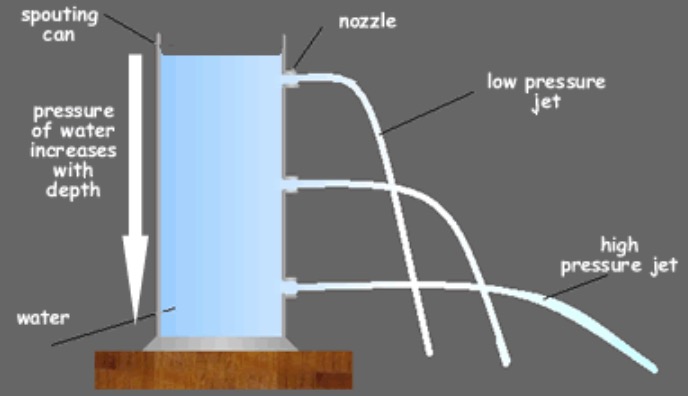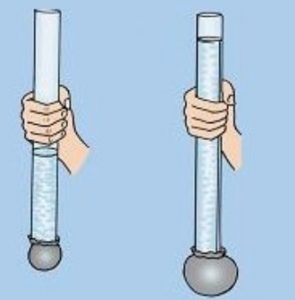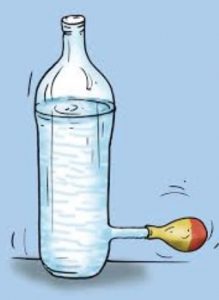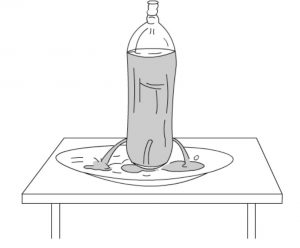Question 1 How does the pressure of a liquid depends on its depth. Explain?
Question 2 What conclusion do you get from the observation that a fountain of water is created at the leaking joint of pipes of the main water supply line?
Question 3 Liquids exert pressure on the wall of contain. Explain?
Question 4 Liquid exert pressure on the bottom of the container. Explain?
Question 5 liquid exerts pressure on the walls of its container. Explain?
Question 6 liquid exerts equal pressure at the same depth. Explain?
All the liquids exert pressure on the base or bottom and walls of their container. All the liquid have weight.
When we pour liquid into a vessel, then the weight of liquid pushes down on the base of the vessel producing a pressure.
The liquid exerts pressure on the base of the vessel.
The pressure exerted by a liquid changes with depth in the liquid. The pressure exerted by a liquid increases with increasing depth inside the liquid. The pressure exerted by a liquid is small just under the surface of the liquid. But as we go we deeper in a liquid the pressure of liquid increases. As the depth of liquid increases the weight of liquid column pushing down from above increases and hence the pressure also increases.
Activity: The pressure of liquid increases with depth
A tall vessel has short and thin tubes fitted at different depth from the top of vessel. The three tubes are of equal diameters and corks are fitted into them. The vessel is filled with water and then all the corks are removed quickly. On removing the corks the water from uppermost tube is found to travel the shortest distance from the base of the vessel, the water from middle tube goes a little farther away whereas water from the lowermost shoots out farthest all. The depth of water near uppermost tube is small so the water comes out from uppermost tube with smaller pressure and falls near the bottom of the vessel. The depth of water near middle tube is greater so the water comes out with greater pressure from middle tube and falls farther away from the base of vessel. The depth of water near lowermost tube is the greatest so the water comes out of lowermost tube with the greatest pressure and goes farthest from the vessel. As the depth of water increases the pressure of water gradually increases.
The greater the depth of a point in a liquid, the greater is the pressure.
Liquids also exert pressure on the walls of the vessel in which they are stored. The sideways pressure exerted by liquids also increases with the depth of the liquid. The sideways pressure of a liquid on walls of a vessel is almost zero at its surface. As the depth of liquid increases the sideways pressure on the walls of the vessel gradually increases and it becomes maximum near the bottom of the vessel.
The wall of a dam is made thicker at the bottom so as to tolerate very high sideways pressure exerted by deep water stored in the reservoir of dam.
Activity : Liquid exert pressure on the bottom of its container which depends on the height of its column
Take a transparent plastic pipe. Also take a thin sheet of a rubber. Stretch the thin rubber sheet and tie it tightly over one end of the plastic pipe. The plastic pipe is the container which has stretchable bottom made of a thin rubber sheet. keeping the pipe vertical, let us pour some water in the pipe from the top .We will find that on pouring water in the pipe, the rubber sheets tied to its bottom stretches and bulges out. The bulging out of rubber sheet demonstrates that the water poured in pipe exerts a pressure on the bottom of its container. This is because the bottom of container is made of a flexible, thin rubber sheet which can get stretched by the pressure exerted by water to form a buldge. Now pour some water in the plastic pipe so that height of water column in the pipe increases. As the height of water column increases the bulge in the rubber sheet also increases showing that the pressure of water on the bottom of its container has increased. Greater the height of water column in the pipe greater will be the bulge in its rubber sheet bottom.
We conclude that:
(1) A liquid exerts pressure on the bottom of its container.
(2) The pressure exerted by a liquid depends on the height of the liquid column.
Activity: A liquid exerts pressure on the walls of its container
Take a plastic bottle. Fix a small glass tube above the bottom of the plastic bottle. We should seal the joint of glass tube with plastic bottle by using molten wax so that water does not leak from the joint. Tie a thin sheet of rubber tightly on the open end of glass tube. Now fill half of plastic bottle with water. On filling water, the rubber sheet tied to the mouth of glass tube gets stretched and bulges out. The bulging out of rubber sheet tied to the glass tube fixed in the wall of plastic bottle demonstrates that water present in plastic bottle exerts pressure on the walls of the bottle. It is the sideways pressure exerted by water which inflates the thin rubber sheet forming a buldge. If we pour more water in the plastic bottle to increase depth, we will see that the bulge in the rubber sheet increases. This indicates that the pressure exerted by water increases with increasing depth.
(1) The pressure exerted by a liquid on the walls of container increases with increasing depth.
(2) A liquid exerts pressure on the walls of its container.
Activity: A liquid exerts equal pressure at the same depth
Take a plastic bottle. Make 2 small holes of equal size on the two opposite sides of the plastic bottle some distance above the bottom of the bottle. The holes should be at exactly the same height from the bottom of the plastic bottle. Now fill the bottle with water. The two jets of water coming out of the two holes fall at the same distance away from the base on its either side. The two jets of water can fall at equal distance on the two sides of the bottle only if the pressure of water at the depth of 2 holes in the bottle is equal.
We conclude that
(1) A liquid exerts pressure on the walls of its container.
(2) A liquid exerts equal pressure at the same depth.
The formation of fountains of water from the leaking pipes of water supply pipeline tells us that water exerts pressure on the walls of its container.




Please provide some videos also for better understanding.
Thank u
sure.i m working on it.
good work guys.
Thank you very much. You guys helped me a lot
THANK YOU SO MUCH…….This is really very helpful RESOURSE…..
thankyou i liked the answer
thank you
It is very helpful note for me
very nice…. Thanks
what i need was in proper form of an activity
All the information given by u are very helpful and beneficial, helped me in my hhw.
Thankyou very much
Please explain with diagrams, so that I can understand properly.
Thanks.
I have added few diagrams in the above post. Hope it will help u to understand the topic more clearly.
Thanks alot shilpi ji…you are doing a great job by explaining the topics in a very simple, straight and easy way. God bless you
It is helpfull to study and thank u for free education on websites
Thanks for your activities it helped me a lot
My sir said to present a seminar on the 3rd law of liquid pressure and you helped me a lot on that.
thank you it was helpful
Thank you so much I find it very easy to understand
Thank u so much for explaining in such a better way. It is immensely easy to discern all the topics explained by u. Once again thanku so much
thank you very very much …
It was nice and quite interesting
It realy help me ❤️
Thank u it helped me atol for my work
it was so nice of u to help us
I am really happy about your service thank you so much
It was very helpful
Nice
Work
I found a real help from it
thanks
NIce, really helpful 🙂
It is a very good work☺